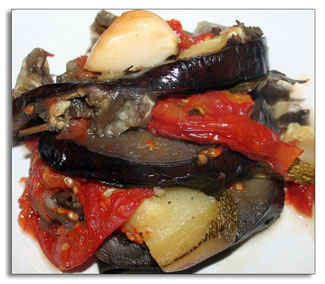|
|
Heaven and earth in a bowlby Ari LeVaux But I’m biased. I sometimes call my sweetheart Ratatouille, so it’s no wonder I want to name a goddess after her. One of those half-mortal goddesses that comes from a rustic village, has pouty lips and speaks with a crude French accent. They have those, right? Ratatouille is also the name of a 2007 animated movie that, I was shocked to realize as I watched it, is basically all about me. And no, I’m not implying that I’m a goddess. I’m simply a personality split three ways among the movie’s three major characters: the rat, the klutz and the critic. Like me, Remy the rat is endowed with a large nose and an intuitive culinary compass. We share a fascination with the way distinct ingredients interact when chewed together, and how previously undetected flavors can be drawn out by inspired pairings. “Each flavor is totally unique,” Remy remarked at one point, as he co-munched two found morsels. “But combine one flavor with another, and something new is created.” Then there’s Linguini, the awkward janitor who has no business in the kitchen other than cleaning it, and who, left to his own devices, is more proficient at creating a mess than anything worth eating. Perhaps everyone has a little Linguini in them. He is the embodiment of choking, failure, inadequacy. I often feel my inner Linguini when I’m cooking for others, and all of my kitchen grace and intuition flies out the window. Or catches on fire. Like Linguini, I know the fear of being discovered a fraud. The third half of my split personality is Anton Ego, the snobby food critic who wields his power with imperial ruthlessness. He gets to judge without submitting himself to judgment, and can ruin – or at least damage – careers with just a few strokes of his pen. Having been a newspaper restaurant critic for many years, I’ve tasted this power, and felt the intoxication it can give. It ain’t pretty. The dramatic crux of the movie comes when Mr. Ego sits down to review Linguini’s food, which has begun attracting attention thanks to the secret coaching of Remy the brilliant rat. As the feared critic takes his seat, Remy decides that they will serve him ratatouille. “But that’s a peasant dish!” gasps Collette, the feisty assistant chef with the hot Parisian accent. She is understandably skeptical. Ratatouille is hardly the stuff of haute cuisine. Just a few coins at the market can purchase all the lowly ingredients you need. But Remy’s rainbow-colored creation emerged from Linguini’s kitchen as something far greater than the sum of its parts. The critic was wowed, the klutz became the hero and got the girl, while the rat got to stay in the kitchen. In that moment my split parts re-collided, were mortared together by ratatouille, and I felt whole. And somehow, but in a different, way, this is what happens when my sweetheart makes ratatouille. If I’m a hybrid of cartoon characters, she is a mix of earth-grown bounty. Interestingly, cooking is not her strong suit. But when she cooks ratatouille she becomes my temporary barefoot kitchen garden goddess. She appears to meditate as the house fills with smells, and I can taste a year’s worth of meals as the counter fills with pint jars full of ratatouille. When I try to make it myself, she puts on the critic pants. That’s why it’s her recipe, not mine, that follows. It’s on the eggplant parmesan end of the ratatouille spectrum, and can be nudged further that way with cheese, if you wish. The basic proportions are one part summer squash, two parts eggplant, and three parts tomato. Cut everything into half-inch slices. Bake at 350 for roughly an hour per inch of the casserole’s depth. Test it for doneness by tasting the eggplant. Ratatouille made with paste tomatoes will cook quicker. You want to cook it until there’s almost no water left, but if you dry it out too much, the layers will curl and warp like old coats of paint. The finished product can be enjoyed immediately, left for days in the fridge where it will continue to improve, or frozen in jars for year-round consumption whenever it’s time for a summertime flashback. (Don’t add cheese if freezing it.) Serve your ratatouille over toast or pasta, or do like we do and gobble it out of the pan, or inhale it straight out of the jar. Even if your garden isn’t big enough to fill your freezer with ratatouille, late summer will often present good deals on the ingredients, either at the store or farmers market, because the supply is so strong. Ratatouille can serve as a bridge between many distant places, including cartoon and reality, city and country, humble and high maintenance, mortals and Gods, and even pieces of your own self. And in winter, when you’re wanting summer, a taste of ratatouille is like a kiss from the sun. |


